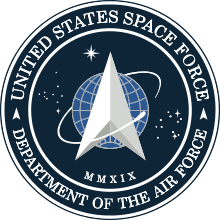50th Space Wing
The 50th Space Wing is a United States Space Force wing assigned to Space Operations Command and stationed at Schriever Air Force Base.[5] The 50th Space Wing is responsible for space superiority and space operations. It was activated as a space wing on 30 January 1992, replacing the 2nd Space Wing.
| 50th Space Wing | |
|---|---|
 Shield of the 50th Space Wing | |
| Founded | 16 May 1949; 71 years, 1 month |
| Country | |
| Branch | |
| Type | Space wing |
| Role | Space operations |
| Size | 8,000 personnel [1] |
| Part of | Space Operations Command |
| Garrison/HQ | Schriever Air Force Base, Colorado, U.S. |
| Motto(s) | "Master of Space" |
| Engagements | Normandy Northern France Rhineland Ardennes-Alsace Central Europe Liberation and Defense of Kuwait[2] |
| Decorations | Air Force Outstanding Unit Award[3] |
| Website | www |
| Commanders | |
| Commander | Col James E. Smith[4] |
| Vice Commander | Col Jack D. Fischer |
| Command Chief | CCM Boston A. Alexander |
Operations
The 50th Space Wing is the United States Space Force's space operations and space superiority wing. The 50th Space Wing operates the Global Positioning System (GPS), Defense Satellite Communications System (DSCS), Wideband Global Satellite Communications system, Military Strategic and Tactical Relay, Defense Meteorological Satellite Program, Space Based Space Surveillance system, Operationally Responsive Space satellite system, Advanced Extremely High Frequency satellite system, and the Boeing X-37B Orbital Test Vehicle. It also operates the Air Force Satellite Control Network.[6]
The 50th Space Wing is also the host unit for Schriever Air Force Base, providing base support for the reserve 310th Space Wing, Strategic Command's Joint Functional Component Command for Integrated Missile Defense, and the Army's 100th Missile Defense Brigade.[7]
Structure
![]()


- Detachment 1, 50th Operations Group, Suitland, Maryland
![]()

- Detachment 1, 21st Space Operations Squadron, Naval Support Facility Diego Garcia
- Detachment 2, 21st Space Operations Squadron, Andersen Air Force Base
- Detachment 3, 21st Space Operations Squadron, Kaena Point Satellite Tracking Station

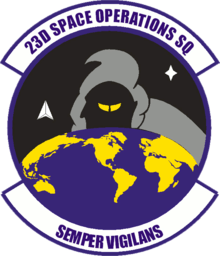
- Detachment 1, 23rd Space Operations Squadron, Thule Air Base
- OL-A, 23rd Space Operations Squadron, RAF Oakhanger

![]()





![]()
750th Operations Group (750 OG)


- 50th Operations Support Squadron (750 OSS)
History
- See 50th Operations Group for additional history and lineage
50th Fighter Wing
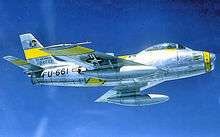
The 50th Fighter Wing was established on 16 May 1949 as part of the United States Air Force Reserve on 1 June 1949. The wing was formed at Otis AFB, Massachusetts. The 50th Fighter Group was assigned to the newly formed 50th Fighter Wing upon activation under the Hobson Plan. It was in the reserves between June 1949 and June 1951, being the counterpart of Air Defense Command's 33d Fighter Wing. The wing was ordered to active service on 1 June 1951 due to the Korean War, and its personnel and equipment were reassigned as replacements to active-duty units. The 50th Fighter Wing was inactivated the next day, 2 June 1951.[9]
50th Fighter-Bomber Wing
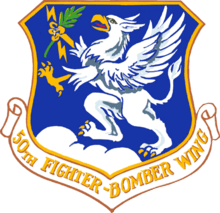
On 1 January 1953, the 50th Fighter-Bomber Wing was reactivated as part of the Tactical Air Command. The group was reactivated following Secretary of State John Foster Dulles' promise to provide NATO with four additional tactical fighter wings to increase its defenses against the Soviet Union due to the outbreak of the Cold War. The 50th Fighter-Interceptor Group activated as the 50th Fighter-Bomber Group (later renamed 50th Operations Group) and became the wing's primary combat element. The group's squadrons were equipped with North American F-86F Sabres, and training commenced for operational proficiency. Once training levels for pilots and aircrews had reached operational levels, the 50th FBW began preparations for its move to West Germany. On 10 August 1953, the 50th FBW arrived at its new home, the newly constructed Hahn Air Base.[9]
The 50th FBW was assigned to the United States Air Forces in Europe's Twelfth Air Force. The wing became the first tactically operational Air Force wing in 12th Air Force's jurisdiction. The 50th FBG consisted of the 10th, 81st and 417th Fighter-Bomber Squadrons. The first of the wing's new F-86H Sabres arrived at Hahn AB 21 October 1955. Conversion continued throughout the winter of 1955 and spring of 1956, ending in May.[10] The 50th FBG received seventy-four F-86Hs, and also had two C-47 transports which were assigned to the Wing for courier and supply operations.[11] The primary mission of the 50th FBW at Hahn was the delivery of tactical nuclear weapons against Warsaw Pact forces in the event of an invasion of Western Europe. Its secondary missions were tactical air defense and support for NATO ground forces.[11]
While 50th FBW prepared for and converted to the newer F-86H, the wing expanded its mission responsibility to include supporting 12th Air Force's 7382d Guided Missile Group. The wing had previously supported the 69th Tactical Missile Squadron at Hahn, which operated the MGM-1 Matador tactical missile.[10] New aircraft would not be the only change for the personnel of the 50th, however. With the conversion to the F-86H nearly complete on 15 April 1956, the wing began a move to Toul-Rosières Air Base, France. The reason for the move was that USAFE war planners believed that due to the vulnerability of West Germany to Soviet attack, having nuclear-equipped fighter wings in West Germany made them vulnerable to being quickly overrun by Warsaw Pact forces. By moving them west into France, it would give NATO more time to respond. This movement took most of the summer of that year. The wing reported it was mission-ready at Toul-Rosières on 1 August.[12]
The 50th Fighter-Bomber Group was inactivated 8 December 1957 as a result of the 50th adopting the Tri-Deputate organization plan. As result of the group's inactivation, its operational squadrons—the 10th, 81st and 417th Fighter Squadrons were assigned directly to the wing.[10]

In 1957 USAFE also announced that the 50th FBW would receive the new F-100D Super Sabre. This advanced, supersonic aircraft significantly improved the wing's combat capability and enhanced European air defenses. The 50th FBW was the third and last USAFE fighter wing to convert into Super Sabres and converted to the new aircraft in 1957 and 1958.[11]
50th Tactical Fighter Wing
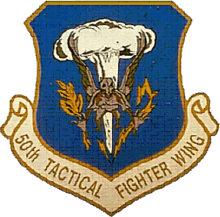
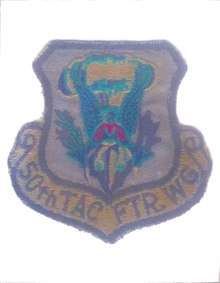
On 8 July 1958, it became the wing was renamed the 50th Tactical Fighter Wing as a result of a worldwide USAF renaming convention, a designation it would carry for almost 35 years.[12]
Around this time, the wing updated its emblem to reflect its new mission and aircraft. The modified design depicted a griffin facing forward and breathing fire with its wings spread. An atomic "mushroom" cloud was centered behind the griffin. Behind the beast's right talon, an olive branch denoted peace. A lightning bolt behind the left talon symbolized the strength and power of the unit's aircraft. The wing would carry this emblem until its inactivation in 1991.[12]
Political issues with France with regards to non-French military forces stationing nuclear weapons, or nuclear-capable units on French soil led to the United States moving the 50th TFW and other tactical wings out of France.[11] Pferdsfeld AB, West Germany was initially considered as the new home of the 50th TFS, however it was decided to return the wing to Hahn AB since it was only partially occupied at the time and the runway at Hahn had just been recently re-paved. The wing, its support units, 10th TFS and 81st TFS returned to Hahn AB, West Germany as part of Operation Red Richard.[11] The 417th TFS was detached to the 86th Tactical Fighter Wing at Ramstein AB, West Germany. The 50th Tactical Fighter Wing reported its movement complete to Hahn on 10 December 1959.[12]
During the Cuban Missile Crisis in October and November 1962, the wing hosted the 435th Tactical Fighter Squadron from Moron AB, Spain as part of a massive military buildup. After the Cuban Missile Crisis ended, the 50th TFW resumed normal operations and participated in various exercises and competitions, often with other NATO allies.[12]

By the mid-1960s, the Super Sabres were becoming vulnerable to a new generation of Warsaw Pact fighters, such as the Mig-21 and Sukhoi Su-15. In response, the wing's three tactical squadrons, the 10th, 81st, and 417th, began converting to McDonnell Douglas F-4D Phantom IIs on 8 October 1966. When the last F-100 left Hahn, 50th TFW aircrews had logged over 143,000 flight hours. Throughout the conversion to the F-4D, the 417th TFS remained detached to the 86th Air Division at Ramstein AB. The 496th Fighter-Interceptor Squadron, attached to the 50th TFW but assigned to the 86th Air Division, did not convert to the new F-4D aircraft, instead flying the F-102 Delta Dagger interceptor aircraft.[12]
The wing underwent another organizational change on 15 July 1968. The costs of the ongoing Vietnam War were stretching defense budgets, and the costs of maintaining large United States forces in Europe, as well as the decision by France to withdrawal from the NATO integrated military alliance led to the development of "dual-based" forces, stationed in the United States, but deployable to NATO in case of a crisis with the Soviet Union. The 417th TFS was reassigned to Mountain Home AFB, Idaho, and was subsequently reassigned to Tactical Air Command's 67th Tactical Reconnaissance Wing. The 417th was "committed" to USAFE, and was planned to deploy to USAFE annually. To replace the 417th, USAFE reassigned the 496th Fighter-Interceptor Squadron back from 86th Air Division to the 50th Tactical Fighter Wing. The 417th, however, remained equipped with F-102 interceptors with an air defense mission. USAFE then selected the 81st Tactical Fighter Squadron as the command's first "Wild Weasel" surface-to-air missile suppression unit. The squadron's primary mission focus changed from ground and air attack roles to location and elimination of threats posed by enemy radar tracking and surface-to-air missile systems. The "Wild Weasel" version of the F-4E (and later the F-4G) could be used as a radar jamming platform or as a search and destroy vehicle.[12]
The 81st TFS moved to Zweibrücken Air Base, West Germany, on 12 June 1971. Though it remained assigned to 50th TFW, 81st TFS was detached from the wing's operational control and attached to the 86th Tactical Fighter Wing. Following these changes, the wing settled into a more routine operations tempo and returned its attentions to maintaining combat readiness. Within two years, USAFE redesignated 496th FIS as a tactical fighter squadron. The squadron then converted to the F-4E Phantom, retiring its F-102s.[12]
The wing continued routine training operations throughout the 1970s. In 1976, the 313th Tactical Fighter Squadron was reactivated as a result of the 36th TFW at Bitburg AB receiving F-15 Eagles, and sending a squadron of its F-4E Phantom IIs to Hahn.[12]
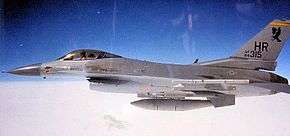
In late 1978 USAFE announced that the 50th Tactical Fighter Wing would test and then field of the new F-16A Fighting Falcon. Arrangements for the tests began with arrival of the first of four teams in November 1978 and continued into 1979. Tests began on 20 April 1979, with four F-16A Block 1 aircraft at Hahn Air Base, Germany.[13]
Meanwhile, prompted by the news of its selection to receive the Air Force's newest fighter, the 50th TFW began construction of new hardened aircraft shelters, additional hangars, maintenance shops and support buildings. In addition contracts were issued for the construction of 300 additional housing units in communities near Hahn AB.[13]
Aircrews focused on training under a new graduated combat capability program that provided specific training events and competency levels for each category of crewmember. Maintenance personnel concentrated on learning F-16 specific requirements and adapted the Production Oriented Maintenance Organization to meet the needs of the new jets and mission. The 313th TFS accepted the first of the wing's new F-16s on 30 December 1981, after a vigorous acceptance inspection—a practice that continues today. Within six months, the last of the 50th TFW's F-4E Phantom IIs departed Hahn AB, after 16 years and more than 176,000 flight hours.[13]
For the next several months, 50th TFW crews frequently deployed to Zaragoza Air Base, Spain, to conduct air-to-air and air-to-ground training. The training included events designed to improve bombing accuracy and increase air and ground crew performance. Before the 1983 Thanksgiving holiday, the wing would add yet another line to its list of accomplishments. That opportunity arrived in October, when 50th TFW crews took their F-16s to the Air Force's annual worldwide bombing and gunnery competition—Gunsmoke—where they won the overall competition. Additionally, one of the wing's pilots earned the individual Top Gun award. Personnel continued to demonstrate their excellence when one of the wing's weapons load crews earned first place distinction in USAFE and third place overall in an Air Force-wide competition at the end of 1983.[13]
The wing replaced its F-16A and F-16B Fighting Falcons for the advanced second-generation F-16C and F-16D in 1986.[13]


By the end of the 1980s, the social, economic, and political turmoil in the Soviet Union had reached a boiling point. The Berlin Wall fell, and a new era in Europe began. Former Soviet republics proclaimed their independence and right to self-determination. Talk in Germany quickly turned to the possibility of reuniting East and West. Debate followed on the future role of American forces in Europe, and worldwide change loomed imminent.[14]
Throughout the spring and summer of 1990, the 50th TFW continued its aggressive training schedule. Meanwhile, American military and government officials debated the new role and structure of the armed forces in light of perceptions of a diminished threat to Western Europe. The changes brought about by events in the Soviet Union and in light of increasing public and governmental concern over the United States' increasing budget deficit. For many, the possibility of any combat activity seemed unlikely, but that perception changed almost in the blink of an eye during the autumn of 1990.[14]
While the wing's aircrews continued their normal operations in West Germany and Turkey, Iraqi president Saddam Hussein resumed a war of rhetoric against Kuwait. As the summer heat in Southwest Asia intensified, so did Hussein's war of words. Iraqi forces crossed the border into Kuwait on 2 August 1990, forcing the Kuwaiti royal family and existing government to seek refuge in neighboring countries. The United Nations condemned the invasion, calling for immediate withdrawal of all Iraqi forces from Kuwait.[14]
Returning to Hahn AB following an October 1990 training deployment to Zaragoza AB, Spain, 10th TFS commander Lt. Col. Ed Houle received notice to prepare his unit for possible deployment. Originally scheduled for a Thanksgiving Day movement, plans changed and called for the deployment of the 10th within 72 hours of the outbreak of hostilities, should that happen.[14]
As the final days of autumn passed and winter began, plans again changed. Word came that the 10th TFS would deploy on 15 January 1991, to fill out the combat strength of the fighter wing at Al Dhafra Air Base, United Arab Emirates. United States Central Command readjusted this date twice, finally establishing a deployment date of 1 January 1991. Meanwhile, crews continued to train and make other preparations. The 313th TFS selected six F-16Cs and eight pilots as potential replacements for lost jets and crews.[14]
Thirty F-16Cs left Hahn AB, for Zaragoza AB 29 December 1990. Six served as airborne spares to replace any of the original 24 that might not complete the trip to Al Dhafra. While hundreds of personnel at Zaragoza AB celebrated and welcomed the new year, thirty pilots of the 50th TFW fired their afterburners, drowning the sounds of celebration, and lifted into the darkness bound for the Middle East and the near certainty of combat. When they arrived, aircrews learned they would not employ the low-level procedures they had practiced for use in Central Europe. Instead of low-level ingress and 10- to 30-degree dive angles, they would deliver their payloads from nearly 20,000 feet with ingress angles near 60 degrees. As training progressed, crews from the 10th TFS began sitting alert with crews of the 17th and 33d TFSs, hoping that they might be the first to strike if war erupted.[14]
15 January 1991, passed with Al Dhafra's crews and much of the coalition forces watching events unfold on cable television news. International news broadcasts, beamed via satellite, told of Iraq's refusal to withdraw and the resulting discussions on how the U.N. coalition would proceed. 16 January 1991 was much the same.[14]
Then, with a click of the second hand, Desert Shield became Desert Storm. At 4 a.m. local time 17 January, the first 40-plane strike package left Al Dhafra for targets in Iraq. The 10th TFS flew its first combat sorties of the war later that afternoon, led by squadron commander Lt. Col. Edward Houle. The assigned target for the eight-ship element of the 10th TFS was Al Taqaddum Airfield, near Baghdad—a round-trip of more than 1,400 miles and an eight-hour mission for crews accustomed to training flights of only one to three hours. For nearly six weeks, 10th TFS crews attacked Iraqi airfields, communication centers and military command centers. What few Iraqi fighters did fly were either shot down or chased across the Iraq-Iran border.[14]
After initial attacks against static targets, the 10th TFS crews received new orders. Iraq had begun using Soviet SS-1 Scud missiles in retaliation against the coalition's offensive air strikes, targeting both coalition forces and Israeli civilian population centers. In response, U.S. Central Command ordered search-and-destroy missions against Iraqi mobile and fixed SCUD launchers. Attacking those targets put 10th TFS pilots at greater risk. A good kill required locating and identifying the SCUD's associated radar once it was activated for launch, and the launchers were heavily defended. The squadron's first SCUD patrol mission began 19 January, only three days into Desert Storm.[14]
The mission changed again 23 January. With most of the strategic targets eliminated, the 10th TFS received orders to concentrate on Iraq's Republican Guard units occupying Kuwait and Iraq's southern region. For the Al Dhafra-based crews, this meant bombing any military targets on the road and destroying any pontoon bridges being constructed across the Tigris River. In addition, the wing's crews dropped leaflet bombs over Iraqi positions and civilian centers. For the next month, emphasis centered on counter-SCUD operations and preparing the battlefield for the eventual ground war.[14]
When the ground war began 25 February, crews began flying combat air patrols, protecting and supporting coalition ground forces. This mission, however, lasted only three days. On the morning of 28 February, the offensive ceased to allow Iraqi units to withdraw. After a brief interlude, crews returned to combat air patrols to enforce ceasefire accords that prohibited Iraqi aircraft from operating within defined areas. This provision of the ceasefire sought to protect coalition ground forces, U.N. personnel who would monitor Iraq's compliance with Security Council resolutions and civilian populations.[14]
With the return of deployed elements from Saudi Arabia in the summer of 1991, the 50th Tactical Fighter Wing was gradually inactivated during the balance of the year. With the reuniting of East and West Germany in October 1990, the Cold War threat of an invasion by the Soviet Union no longer was an issue. The United States was left with a huge excess capacity of expensive airfields in Europe. The 50th had performed its mission successfully in Western Europe and it was now time to end its mission.[14]
As a result, the 50th TFW was inactivated in 1991 after 35 years at Hahn Air Base. The 496th TFS was inactivated on 15 May; The 313th TFS on 1 July, and the 10th TFS on 30 September. The 50th Tactical Fighter Wing was inactivated on 30 September 1991.[14]
50th Space Wing
As part of the general reorganization of the Air Force in the post–Cold War era, The 50th TFW was reassigned to Air Force Space Command, which reactivated the wing as the 50th Space Wing on 30 January 1992, at Falcon Air Force Base east of Colorado Springs, Colorado. The 50th was reactivated as part of the USAF Heritage Program, in which notable historic wings remained on active duty, replacing younger ones. The 50th Space Wing assumed control of the personnel and assets of the 2d Space Wing, which was immediately inactivated.[15]
At the same time, the command activated the 50th Operations Group, the redesignated World War II and early Cold War-era 50th Fighter Group, and assigned it to the 50th Space Wing as part of the post Cold War USAF Objective organization plan. AFSPC also activated the 50th Maintenance and Supply Group and the 50th Combat Support Group under new names, creating a wing organization that closely resembled that of the 1950s.[15]
Squadrons assigned to the 50th concurrent with its activation included a mixture of past units and those previously assigned to the 2d Space Wing, which the 50th SW replaced. The command activated the 50th Mission Support, Civil Engineering, Security Police, Communications, Airdrome, Air Service, Depot Repair and Depot Supply Squadrons with new designations. Transferred from the 2nd Space Wing were the 1st, 2nd, 3rd and 5th Satellite Control Squadrons, renamed Space Operations Squadrons. The headquarters of the 2nd Satellite Tracking Group became Headquarters 750th Space Group and transferred to 50th SW. The 50th SW also assumed responsibility for a number of detachments operating around the world.[15]
The 50th SW assumed command-and-control responsibilities for several existing satellite constellations that provided a variety of critical information to the Air Force, Department of Defense and other users. Additionally, the 50th SW assumed responsibility for the Air Force Satellite Control Network, which allowed satellite controllers to fly satellites under their command.[15]
Continuing activity resulting from the 1995 Defense Base Closure and Realignment Commission (BRAC) report resulted in the inactivation of the 750th Space Group and the 5th Space Operations Squadron at Onizuka Air Force Station, California, in 1999 and 2000 respectively. The inactivation of other agencies and units at Onizuka AFS left 21st SOPS as the installation's host, and the 21st SOPS commander assumed installation commander responsibilities.[16]
The 50th Space Wing supports allied operations in Southwest Asia with satellite communications, GPS enhancements and deployed personnel. By 2005, the 50th SW averaged 80 Airmen per month deployed to forward operating bases in Afghanistan supporting the Global War on Terrorism.[16]
During Operation Iraqi Freedom 2d SOPS crews developed new techniques for enhancing GPS accuracy over the Iraqi theater of operations between 20 March and 10 April. The 1st SOPS set a record during this period, placing a GPS satellite in orbit and completing all early on-orbit checkout activities in only 11 days providing Defense Support Program and GPS support. 3rd and 4th SOPS crews maximized satellite communications coverage of the theater. The 3rd SOPS' Defense Satellite Communications System Block III satellites provided 80 percent of in-theater bandwidth. Meanwhile, 4th SOPS dedicated 85 percent of Milstar communications capability to the war effort.[16]
The 50th Network Operations Group (previously the 50th Communications Group) supported all of the wing's satellite command-and-control activities through the Air Force Satellite Control Network scheduling nodes, managed by 22nd SOPS. Personnel at the wing's remote tracking stations, including 21st SOPS at Onizuka AFS and 23rd SOPS at New Boston AFS, N.H., logged more than 12,312 satellite contacts while assisting with other satellite operations and three satellite launches.[16]
The 50th SW also underwent organizational changes in the first years of the new century. To correct inefficiencies and realign organizations along mission lines, Air Force Space Command renamed the 50th CG as 50th NOG and reassigned 21st, 22nd and 23rd SOPS to that organization. Functions of the 850th Space Communications Squadron merged with those of 50th SCS, and the 850th SCS inactivated in January 2006.[16]
On 20 December 2019, the 50th Space Wing, along with the rest of Air Force Space Command, was transferred to the United States Space Force.[17]
References
- https://www.schriever.af.mil/About-Us/Fact-Sheets/Display/Article/275809/50th-space-wing/
- https://www.afhra.af.mil/About-Us/Fact-Sheets/Display/Article/433468/50-space-wing-afspc/
- https://www.afhra.af.mil/About-Us/Fact-Sheets/Display/Article/433468/50-space-wing-afspc/
- https://www.schriever.af.mil/About-Us/Biographies/
- "50th Space Wing". Schriever Air Force Base. Retrieved 10 January 2020.
- https://www.schriever.af.mil/About-Us/Fact-Sheets/Display/Article/275809/50th-space-wing/
- https://www.schriever.af.mil/Units/
- https://www.schriever.af.mil/Units/
- Saunders, Randy (29 November 2006). "From 'Master of the Sky' to 'Master of Space': 50th FW moves to USAFE, active duty". 50th Space Wing History Office. Archived from the original on 5 April 2014. Retrieved 2 December 2016.
- Saunders, Randy (29 November 2006). "From 'Master of the Sky' to 'Master of Space': 50th gets Sabres, begins tour at Hahn AB". 50th Space Wing History Office. Archived from the original on 5 April 2014. Retrieved 2 December 2016.
- McAuliffe, Chapter 16
- Saunders, Randy (8 December 2006). "From 'Master of the Sky' to 'Master of Space': 50th FW moves 'there and back again'". 50th Space Wing History Office. Archived from the original on 5 April 2014. Retrieved 2 December 2016.
- Saunders, Randy (1 May 2007). "From 'Master of the Sky' to 'Master of Space': F-16s join 50th TFW arsenal". 50th Space Wing History Office. Archived from the original on 5 April 2014. Retrieved 2 December 2016.
- Saunders, Randy (3 May 2007). "From 'Master of the Sky' to 'Master of Space': 50th TFW flies, fights, wins in Desert Storm". 50th Space Wing History Office. Archived from the original on 5 April 2014. Retrieved 2 December 2016.
- Saunders, Randy (27 June 2007). "From 'Master of the Sky' to 'Master of Space': 50th TFW gains new life, new mission in ultimate high ground". 50th Space Wing History Office. Archived from the original on 5 April 2014. Retrieved 2 December 2016.
- Saunders, Randy (26 June 2007). "From 'Master of the Sky' to 'Master of Space': 50th SW faces new millenium, new war". 50th Space Wing History Office. Archived from the original on 5 April 2014. Retrieved 2 December 2016.
- https://www.schriever.af.mil/Portals/17/2019_Heritage_Pamphlet%20pdf.pdf
Bibliography
![]()
- Endicott, Judy G. (1998). Active Air Force Wings as of 1 October 1995 and USAF Active Flying, Space, and Missile Squadrons as of 1 October 1995 (PDF). Air Force History and Museums Program. Washington, DC: Office of Air Force History. ASIN B000113MB2. Retrieved 2 July 2014.
- McAuliffe, Jerome J. (2005). "16, Toul-Rosieres Air Base". U.S. Air Force in France 1950–1967. San Diego, CA: Milspec Press. ISBN 978-0977037117.
- Ravenstein, Charles A. (1984). Air Force Combat Wings, Lineage & Honors Histories 1947–1977. Washington, DC: Office of Air Force History. ISBN 0-912799-12-9.
- Rogers, Brian. (2005). United States Air Force Unit Designations Since 1978. Hinkley, UK: Midland Publications. ISBN 1-85780-197-0.
